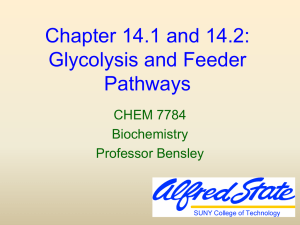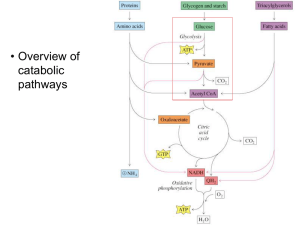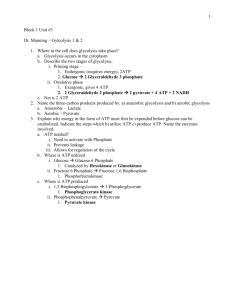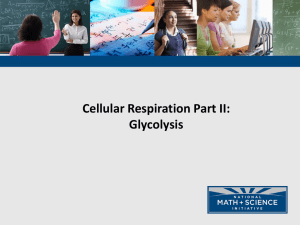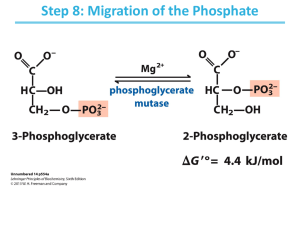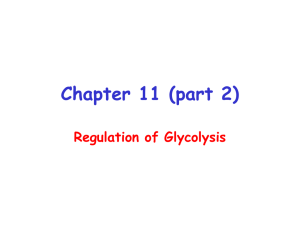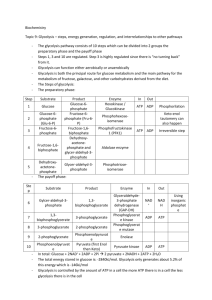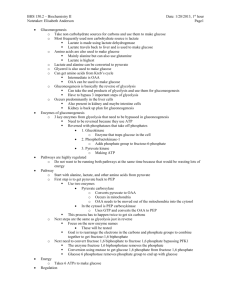Technical_Process_Assignment_
advertisement
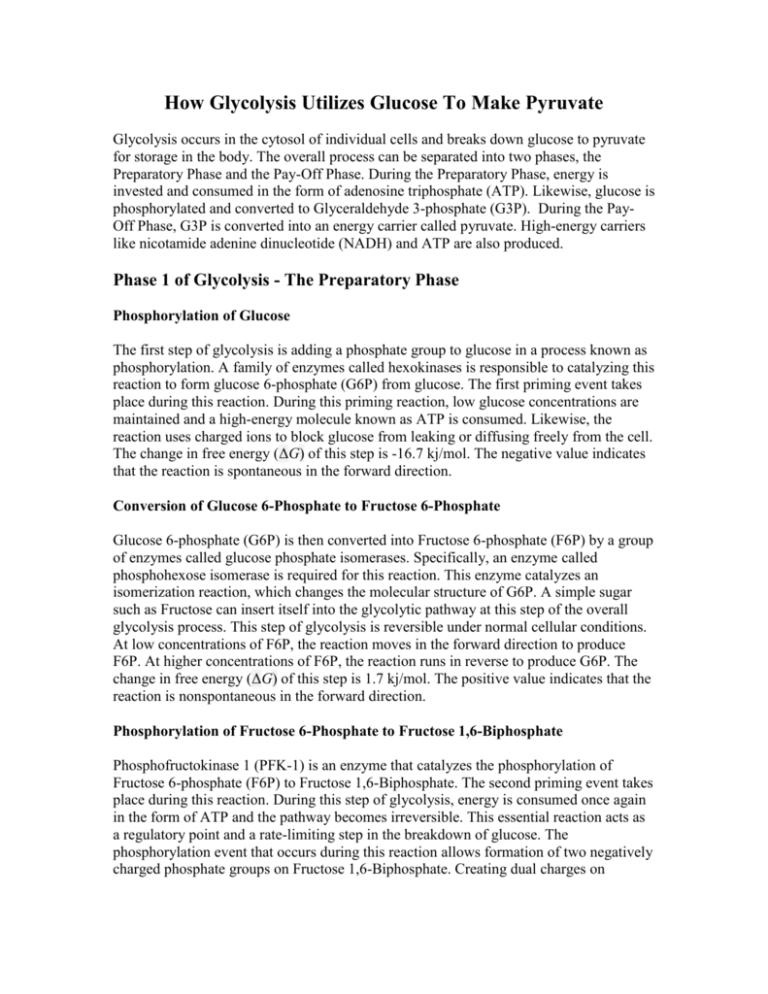
How Glycolysis Utilizes Glucose To Make Pyruvate Glycolysis occurs in the cytosol of individual cells and breaks down glucose to pyruvate for storage in the body. The overall process can be separated into two phases, the Preparatory Phase and the Pay-Off Phase. During the Preparatory Phase, energy is invested and consumed in the form of adenosine triphosphate (ATP). Likewise, glucose is phosphorylated and converted to Glyceraldehyde 3-phosphate (G3P). During the PayOff Phase, G3P is converted into an energy carrier called pyruvate. High-energy carriers like nicotamide adenine dinucleotide (NADH) and ATP are also produced. Phase 1 of Glycolysis - The Preparatory Phase Phosphorylation of Glucose The first step of glycolysis is adding a phosphate group to glucose in a process known as phosphorylation. A family of enzymes called hexokinases is responsible to catalyzing this reaction to form glucose 6-phosphate (G6P) from glucose. The first priming event takes place during this reaction. During this priming reaction, low glucose concentrations are maintained and a high-energy molecule known as ATP is consumed. Likewise, the reaction uses charged ions to block glucose from leaking or diffusing freely from the cell. The change in free energy (ΔG) of this step is -16.7 kj/mol. The negative value indicates that the reaction is spontaneous in the forward direction. Conversion of Glucose 6-Phosphate to Fructose 6-Phosphate Glucose 6-phosphate (G6P) is then converted into Fructose 6-phosphate (F6P) by a group of enzymes called glucose phosphate isomerases. Specifically, an enzyme called phosphohexose isomerase is required for this reaction. This enzyme catalyzes an isomerization reaction, which changes the molecular structure of G6P. A simple sugar such as Fructose can insert itself into the glycolytic pathway at this step of the overall glycolysis process. This step of glycolysis is reversible under normal cellular conditions. At low concentrations of F6P, the reaction moves in the forward direction to produce F6P. At higher concentrations of F6P, the reaction runs in reverse to produce G6P. The change in free energy (ΔG) of this step is 1.7 kj/mol. The positive value indicates that the reaction is nonspontaneous in the forward direction. Phosphorylation of Fructose 6-Phosphate to Fructose 1,6-Biphosphate Phosphofructokinase 1 (PFK-1) is an enzyme that catalyzes the phosphorylation of Fructose 6-phosphate (F6P) to Fructose 1,6-Biphosphate. The second priming event takes place during this reaction. During this step of glycolysis, energy is consumed once again in the form of ATP and the pathway becomes irreversible. This essential reaction acts as a regulatory point and a rate-limiting step in the breakdown of glucose. The phosphorylation event that occurs during this reaction allows formation of two negatively charged phosphate groups on Fructose 1,6-Biphosphate. Creating dual charges on Fructose 1,6-Biphosphate prevents diffusion of intermediates out of the cell. The change in free energy (ΔG) of this step is -14.2 kj/mol so the forward reaction is spontaneous. Cleavage of Fructose 1,6-Biphosphate Upon cleavage at carbon 3 of Fructose 1,6-Biphosphate, a split occurs in the hexose ring. An enzyme called aldolase catalyzes this cleavage reaction to produce two 3-carbon molecules, dihydroxyacetone phosphate and glyceraldehyde 3-phosphate (G3P). The change in free energy (ΔG) of this step is 23.8 kj/mol so the forward reaction is nonspontaneous. Interconversion of the Triose Phosphates 1 Triose phosphate isomerase is an enzyme that catalyzes rapid interconversion of dihydroxyacetone phosphate to glyceraldehyde 3-phosphate (G3P). In doing so, regulation is simplified and two molecules of G3P are now present. These two molecules of G3P are ready to be inserted into the Pay-off Phase of glycolysis. The change in free energy (ΔG) of this step is 7.5 kj/mol so the forward reaction is nonspontaneous. 1 Image from https://biochemuwi.files.wordpress.com/2013/03/image.jpg Phase 2 of Glycolysis - The Pay-off Phase Oxidation of Glyceraldehyde 3-Phosphate to 1,3-Bisphosphoglycerate Oxidation and Phosphorylation both occur during this step of glycolysis. An enzyme called Glyceraldehyde 3-Phosphate (G3P) dehydrogenase removes two molecules of hydrogen from each of the two G3P to form two 1,3-Biphosphoglycerates. Two phosphate groups (Pi) and two NAD+ groups are consumed during this reaction. Two molecules of NADH are produced during this reaction. The change in free energy (ΔG) of this step is 6.3 kj/mol so the forward reaction is nonspontaneous. Phosphoryl Transfer from 1,3-Biphophoglycerate to ADP During this reaction, an enzyme named phosphoglycerate kinase catalyzes the production 3-phosphoglycerate. Enzymatic transfer of a phosphate group occurs during this step of glycolysis. Each of the two 1-3-biphosphoglycerate loses a phosphate group. This phosphate group then interacts with an energy-poor molecule known as adenosine diphosphate (ADP). The interaction produces adenosine triphosphate (ATP), which is an energy-rich molecule. The first substrate level phosphorylation occurs during this reaction. Substrate level phosphorylation is the activity that produces the energy-rich ATP. When ATP is readily available to cells, this reaction does not occur. Therefore, key parts of regulation occur during this step of glycolysis. The change in free energy (ΔG) of this step is -18.9 kj/mol so the forward reaction is spontaneous. Conversion of 3-Phophoglycerate to 2-Phosphoglycerate An enzyme called phosphoglycerate mutase catalyzes the formation of 2Phosphoglycerate from 3-Phophoglycerate. During this mutation reaction, a phosphate group is shifted one carbon to the 2nd position from the 3rd position. The change in free energy (ΔG) of this step is 4.4 kj/mol so the forward reaction is nonspontaneous. Dehydration of 2-Phosphoglycerate to Phosphoenolpyruvate An enol condensation takes place during this step of glycolysis. An enol condensation is a dehydration reaction where a water molecule is removed from the compound. An enzyme called enolase catalyzes the formation of two phosphoenolpyruvate from two 2Phosphoglycerate. As a result, a carbon-carbon double bond is formed between the 2nd and 3rd carbon of phosphoenolpyruvate. The change in free energy (ΔG) of this step is 1.8 kj/mol so the forward reaction is nonspontaneous. Transfer of Phosphoryl Group from Phosphoenolpyruvate to ADP During the final step of glycolysis, the second substrate level phosphorylation occurs. Substrate level phosphorylation uses ADP and a phosphate group to produce energy-rich ATP once again. An enzyme called pyruvate kinase catalyzes the formation of 2 pyruvate molecules from 2 phosphoenolpyruvate. Regulation occurs at this step, and the final pyruvate product can be metabolized to produce oxygen. The change in free energy (ΔG) of this step is -31.7 kj/mol so the forward reaction is spontaneous. 2 Conclusion Glycolysis is a 10-step process that utilizes the breakdown of glucose to produce pyruvate. Pyruvate can then be broken down to produce oxygen for cells. During this process, two high-energy ATP are invested and four ATP are produced. Likewise, a single glucose is broken down into two pyruvate molecules. While steps 1,3,7, and 10 have negative changes in free energy (ΔG), the other steps have positive changes in free energy. Therefore, only 4 of the reactions occur spontaneously. 2 Image from https://classconnection.s3.amazonaws.com/713/flashcards/971713/jpg/payoff_phase-.jpg

